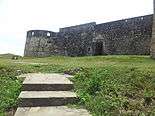Fort Amsterdam, Ghana
Fort Amsterdam, a World Heritage Site is a fort in Kormantin, Central region, Ghana. It was built by the English between 1638 and 1645 as Fort Cormantin or Fort Courmantyne, and was captured by admiral Michiel de Ruyter of the Dutch West India Company in 1665,[1]in retaliation for the capture of several Dutch forts by the English Admiral Holmes in 1664.[2] It was subsequently made part of the Dutch Gold Coast, and remained part of it until the fort was traded with the British in 1868. The Fort is located at Abandze ,on the north-east of Cape Coast in the Mfantseman District of the Central Region of Ghana.
| Fort Amsterdam | |
|---|---|
| Part of Dutch Gold Coast | |
Fort Amsterdam | |
 Fort Amsterdam | |
| Coordinates | 5.192222°N 1.093056°W |
| Site history | |
| Built | 1638 |
| Garrison information | |
| Occupants | English (1631-1665) Netherlands (1665-1868) |
| Location | Abandze, Central Region, Ghana |
| Part of | Forts and Castles, Volta, Greater Accra, Central and Western Regions |
| Criteria | Cultural: (vi) |
| Reference | 34-004 |
| Inscription | 1979 (3rd session) |
History
Early in 1782, Captain Thomas Shirley in the 50-gun ship Leander and the sloop-of-war Alligator sailed to the Dutch Gold Coast. Britain was at war with The Netherlands and Shirley captured the small Dutch forts at Moree (Fort Nassau - 20 guns), Kormantin (Courmantyne or - 32 guns), Apam (Fort Lijdzaamheid or Fort Patience - 22 guns), Senya Beraku (Fort Goede Hoop - 18 guns), and Accra (Fort Crêvecoeur or Ussher Fort - 32 guns).[3]
In 1811, the people of Anomabo , who happened to be allies of the British attacked the fort, leaving it in ruins. It was unoccupied from then until its restoration in 1951 by the Ghana Museums and Monuments Board.[4]
The town of Abandze has grown around the site of the fort today.
The Original Structure of Fort Amsterdam
It had a rectangular outline with two square and two round bastions at the corners. They were linked by curtain walls. There was a central courtyard. Arranged around it were a one-storeyed building on the west side, a two-storeyed building along the north side and a line of two or three storeyed buildings on the south side.
The curtain and bastion on the north were solidly built, while the others were constructed with an earth filling between two walls of stone laid in mortar. The result as cracks and disintegration at the time it was left unoccupied.
The bastion on the southeast, which was designed to be hollow, had a grated ventilation in the roof, and was in addition used as a slave prison. It is believed to have been the first of its kind in the Gold Coast. Slaves taken from this fort were said to have been named "Coromantese' or "Cormantins" [5]
Trade
From 1705-1716, trade figures at the fort were given as 481 marks of gold and 149 slaves. There were complaints of little trade at other times as well. This was due to wars and also because the local chief was said to have leased the site to the British, and not the Dutch. The Dutch had no jurisdiction there, and the Cormantin people blocked their trade routes whenever it suited them, until the former had paid huge sums of money. [6]
Image gallery
 Fort Amsterdam front view
Fort Amsterdam front view%2C_hoofdingang.jpg) Main gate
Main gate.jpg) Fort Amsterdam
Fort Amsterdam Slave Dungeon in Fort Amsterdam
Slave Dungeon in Fort Amsterdam Sunset at the Fort Amsterdam
Sunset at the Fort Amsterdam Komantin Beach From Fort Amsterdam
Komantin Beach From Fort Amsterdam Canon in Fort Amsterdam
Canon in Fort Amsterdam Open skies in Fort Amsterdam
Open skies in Fort Amsterdam
References
| Wikimedia Commons has media related to Fort Kormantin. |
- "Ghana Museums & Monuments Board". www.ghanamuseums.org.
- Anquandah, James. (1999). Castles & forts of Ghana. Atalante: Ghana Museums & Monuments Board. ISBN 2951390106. OCLC 41624572.
- Crooks, John Joseph (1973), Records Relating to the Gold Coast Settlements from 1750 to 1874 (London: Taylor & Francis), p. 62. ISBN 978-0-7146-1647-6
- Anquandah, James. (1999). Castles & forts of Ghana. Atalante: Ghana Museums & Monuments Board. ISBN 2951390106. OCLC 41624572.
- Anquandah, James. (1999). Castles & forts of Ghana. Atalante: Ghana Museums & Monuments Board. ISBN 2951390106. OCLC 41624572.
- Anquandah, James. (1999). Castles & forts of Ghana. Atalante: Ghana Museums & Monuments Board. ISBN 2951390106. OCLC 41624572.